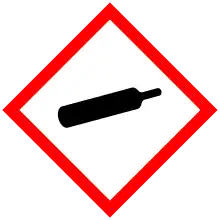| Names | |
|---|---|
| Preferred IUPAC name
Fluoroethene | |
| Other names
Vinylfluoride, Fluoroethylene, Monofluoroethylene, Vinyl fluoride monomer, VF, R 1141, UN 1860 (inhibited) | |
| Identifiers | |
3D model (JSmol) |
|
| 1731574 | |
| ChEBI | |
| ChemSpider | |
| ECHA InfoCard | 100.000.757 |
| EC Number |
|
| 130238 | |
| KEGG | |
PubChem CID |
|
| RTECS number |
|
| UNII | |
CompTox Dashboard (EPA) |
|
| |
| |
| Properties | |
| C2H3F | |
| Molar mass | 46.04 g/mol |
| Appearance | Colorless gas |
| Odor | faint, ethereal[1] |
| Density | 0.636 g/cm3 |
| Melting point | −160.5 °C (−256.9 °F; 112.6 K) |
| Boiling point | −72.2 °C (−98.0 °F; 201.0 K) |
| Slightly soluble | |
| Vapor pressure | 25.2 atm (370.4 psi) |
| Hazards | |
| GHS labelling: | |
   | |
| Danger | |
| H220, H280, H341, H350, H373 | |
| P201, P202, P210, P260, P281, P308+P313, P314, P377, P381, P403, P405, P410+P403, P501 | |
| NFPA 704 (fire diamond) | |
| 385 °C (725 °F; 658 K) | |
| Explosive limits | 2.6 - 21.7% |
| NIOSH (US health exposure limits): | |
PEL (Permissible) |
none[1] |
REL (Recommended) |
TWA 1 ppm C 5 ppm[1] |
IDLH (Immediate danger) |
N.D.[1] |
Except where otherwise noted, data are given for materials in their standard state (at 25 °C [77 °F], 100 kPa).
Infobox references | |
Vinyl fluoride is an organic halide with the chemical formula C2H3F. It is a colorless gas with a faint ether-like odor. It is used as the monomeric precursor to the fluoropolymer polyvinylfluoride.
Production
It was first prepared in 1901 by Frédéric Swarts, the Belgian chemist who was the first to prepare chlorofluorocarbons in 1892. Swarts used the reaction of zinc with 1,1-difluoro-2-bromoethane. It is produced industrially by two routes, one being the mercury-catalyzed reaction of acetylene and hydrogen fluoride:[2]
- HC≡CH + HF → CH2=CHF
It is also prepared from 1,1-chlorofluoroethane:
- CH3CHClF → CH2=CHF + HCl
Safety
Vinyl fluoride is classified as an IARC Group 2A carcinogen (likely to cause cancer in humans).
Additional data
Its critical point is at 54.8 °C (328 K) and 5.24 MPa. Its molecular dipole moment is 1.4 Debye and heat of vaporization is 361 kJ/kg.
See also
References
- 1 2 3 4 NIOSH Pocket Guide to Chemical Hazards. "#0660". National Institute for Occupational Safety and Health (NIOSH).
- ↑ Günter Siegemund, Werner Schwertfeger, Andrew Feiring, Bruce Smart, Fred Behr, Herward Vogel, Blaine McKusick “Fluorine Compounds, Organic” Ullmann's Encyclopedia of Industrial Chemistry, Wiley-VCH, Weinheim, 2002. doi:10.1002/14356007.a11_349
External links
- US Occupational Safety and Health Administration data sheet
- CDC - NIOSH Pocket Guide to Chemical Hazards
- Vinyl fluoride data sheet, EnvironmentalChemistry.com
- Vinyl fluoride data sheet, airliquide.com Archived 2016-03-03 at the Wayback Machine
- MSDS Safety data at inchem.org
- Information about its carcinogenity
